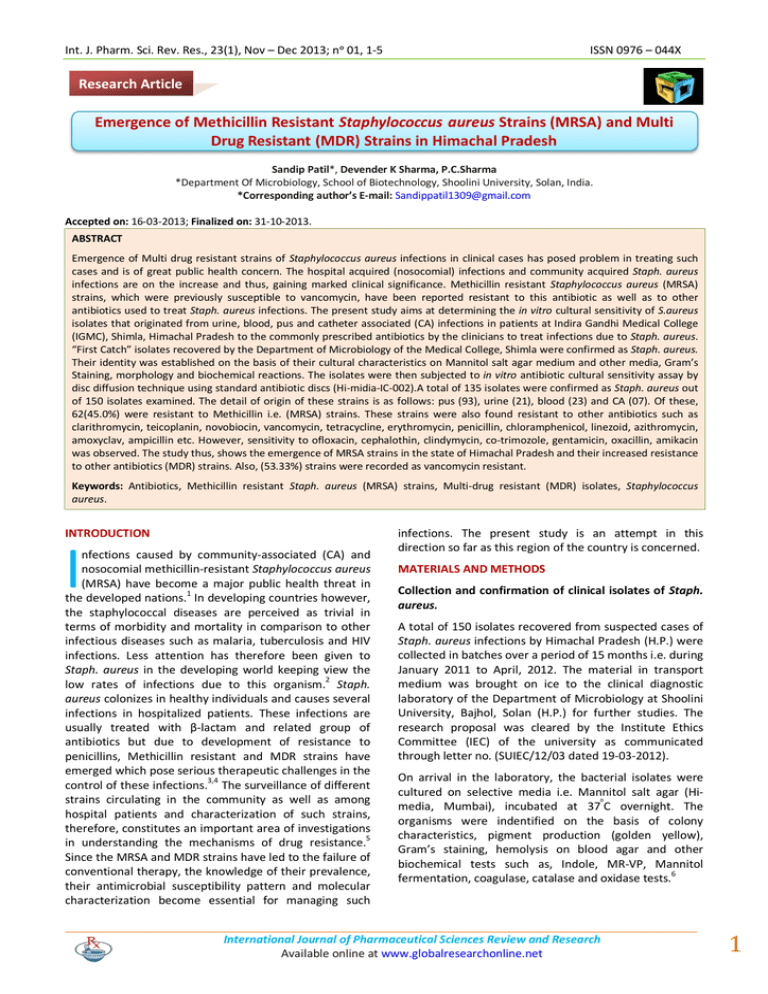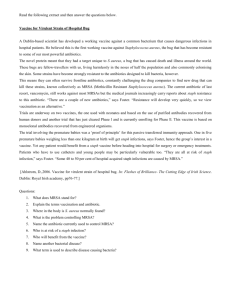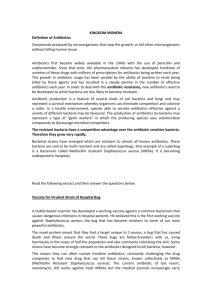Document 13309372
advertisement

Int. J. Pharm. Sci. Rev. Res., 23(1), Nov – Dec 2013; nᵒ 01, 1-5 ISSN 0976 – 044X Research Article Emergence of Methicillin Resistant Staphylococcus aureus Strains (MRSA) and Multi Drug Resistant (MDR) Strains in Himachal Pradesh Sandip Patil*, Devender K Sharma, P.C.Sharma *Department Of Microbiology, School of Biotechnology, Shoolini University, Solan, India. *Corresponding author’s E-mail: Sandippatil1309@gmail.com Accepted on: 16-03-2013; Finalized on: 31-10-2013. ABSTRACT Emergence of Multi drug resistant strains of Staphylococcus aureus infections in clinical cases has posed problem in treating such cases and is of great public health concern. The hospital acquired (nosocomial) infections and community acquired Staph. aureus infections are on the increase and thus, gaining marked clinical significance. Methicillin resistant Staphylococcus aureus (MRSA) strains, which were previously susceptible to vancomycin, have been reported resistant to this antibiotic as well as to other antibiotics used to treat Staph. aureus infections. The present study aims at determining the in vitro cultural sensitivity of S.aureus isolates that originated from urine, blood, pus and catheter associated (CA) infections in patients at Indira Gandhi Medical College (IGMC), Shimla, Himachal Pradesh to the commonly prescribed antibiotics by the clinicians to treat infections due to Staph. aureus. “First Catch” isolates recovered by the Department of Microbiology of the Medical College, Shimla were confirmed as Staph. aureus. Their identity was established on the basis of their cultural characteristics on Mannitol salt agar medium and other media, Gram’s Staining, morphology and biochemical reactions. The isolates were then subjected to in vitro antibiotic cultural sensitivity assay by disc diffusion technique using standard antibiotic discs (Hi-midia-IC-002).A total of 135 isolates were confirmed as Staph. aureus out of 150 isolates examined. The detail of origin of these strains is as follows: pus (93), urine (21), blood (23) and CA (07). Of these, 62(45.0%) were resistant to Methicillin i.e. (MRSA) strains. These strains were also found resistant to other antibiotics such as clarithromycin, teicoplanin, novobiocin, vancomycin, tetracycline, erythromycin, penicillin, chloramphenicol, linezoid, azithromycin, amoxyclav, ampicillin etc. However, sensitivity to ofloxacin, cephalothin, clindymycin, co-trimozole, gentamicin, oxacillin, amikacin was observed. The study thus, shows the emergence of MRSA strains in the state of Himachal Pradesh and their increased resistance to other antibiotics (MDR) strains. Also, (53.33%) strains were recorded as vancomycin resistant. Keywords: Antibiotics, Methicillin resistant Staph. aureus (MRSA) strains, Multi-drug resistant (MDR) isolates, Staphylococcus aureus. INTRODUCTION I nfections caused by community-associated (CA) and nosocomial methicillin-resistant Staphylococcus aureus (MRSA) have become a major public health threat in the developed nations.1 In developing countries however, the staphylococcal diseases are perceived as trivial in terms of morbidity and mortality in comparison to other infectious diseases such as malaria, tuberculosis and HIV infections. Less attention has therefore been given to Staph. aureus in the developing world keeping view the low rates of infections due to this organism.2 Staph. aureus colonizes in healthy individuals and causes several infections in hospitalized patients. These infections are usually treated with β-lactam and related group of antibiotics but due to development of resistance to penicillins, Methicillin resistant and MDR strains have emerged which pose serious therapeutic challenges in the 3,4 control of these infections. The surveillance of different strains circulating in the community as well as among hospital patients and characterization of such strains, therefore, constitutes an important area of investigations 5 in understanding the mechanisms of drug resistance. Since the MRSA and MDR strains have led to the failure of conventional therapy, the knowledge of their prevalence, their antimicrobial susceptibility pattern and molecular characterization become essential for managing such infections. The present study is an attempt in this direction so far as this region of the country is concerned. MATERIALS AND METHODS Collection and confirmation of clinical isolates of Staph. aureus. A total of 150 isolates recovered from suspected cases of Staph. aureus infections by Himachal Pradesh (H.P.) were collected in batches over a period of 15 months i.e. during January 2011 to April, 2012. The material in transport medium was brought on ice to the clinical diagnostic laboratory of the Department of Microbiology at Shoolini University, Bajhol, Solan (H.P.) for further studies. The research proposal was cleared by the Institute Ethics Committee (IEC) of the university as communicated through letter no. (SUIEC/12/03 dated 19-03-2012). On arrival in the laboratory, the bacterial isolates were cultured on selective media i.e. Mannitol salt agar (Hi⁰ media, Mumbai), incubated at 37 C overnight. The organisms were indentified on the basis of colony characteristics, pigment production (golden yellow), Gram’s staining, hemolysis on blood agar and other biochemical tests such as, Indole, MR-VP, Mannitol 6 fermentation, coagulase, catalase and oxidase tests. International Journal of Pharmaceutical Sciences Review and Research Available online at www.globalresearchonline.net 1 Int. J. Pharm. Sci. Rev. Res., 23(1), Nov – Dec 2013; nᵒ 01, 1-5 In Vitro antibiotic culture sensitivity assay The culture of Staph. aureus (each isolates containing about 106cfu/ml) were spread uniformly on Mueller 7 Hinton Agar (Hi-Media, Mumbai). The standard antibiotics discs were then aseptically placed on bacterial lawns in the plates with the help of forceps and allowed to stand for one hour. The plates were then incubated at 37⁰C for 24hours.The activity of each antibiotic against different strains was determined by measuring the diameter of the zone of inhibition around each disc as per standard protocol of NCCLS. (M7-44).8 Screening of MRSA strains by MRSA detection Kit In addition to the resistance observed against methicillin by in vitro antibiotic culture sensitivity assay, screening of MRSA strains was done with MRSA identification Kit (Himedia K-058). RESULTS Confirmation of Staph. aureus isolates Of the 150 isolates screened, 135 were confirmed as Staph. aureus, origin wise detail of the isolates is presented in Table 1. The confirmation was based on growth, cultural characteristics, gram’s staining, heamolysis on blood agar. In vitro antibiotic culture sensitivity assay All the 135 Staph. aureus isolates were tested for their in vitro susceptibility to different antibiotics by disc diffusion method. The sensitivity pattern is given in Table 2. Table 1: Confirmation of Staph. aureus isolates (origin wise) Name of Isolates Pus Urine Blood C.A. Staphylococcus aureus 93 19 16 07 Other Bacteria 6 2 07 00 Total 99 21 23 07 It is evident from the table that most of the isolates were resistant to conventionally used drugs against Staph. aurues viz. penicillin (86.6%), ampicillin (69.6%), cotrimoxazole (70.0%), and the new generation antibiotics azithromycin (68.14%), clarithromycin and linezoid (65.18% each) etc. The drug resistance pattern against different groups of antibiotics used in the present study is given in table 3. The results reflect that majority of the isolates were resistant to β lactam and macrolide groups (69.62% each) followed by oxazolidinone (62.22%) and sulfonamide group (60.00%), tetracycline (51%). However, the percentage of isolates found resistant to other groups of antibiotics (Glycopeptides, Chloramphinicol and Licosamide) (ranged from 33.3% to 45.9%), Of the resistant isolates, three isolates (two from blood and one from pus) were resistant to all the 20 antibiotic used in the study, and nine isolates all from pus were resistant to 15 to 18 antibiotics. ISSN 0976 – 044X Screening for Methicillin resistance by MRSA kit and In vitro antibiotic culture sensitivity assay All MRSA strains produced color change from pink to yellow with agglutination by MRSA detection kit out of a total of 135 isolates, 62 (45.92%) isolates could be detected as MRSA. Of these, 32% MRSA were detected positive by the MRSA kit as well as antibiotic sensitivity assay. In this manner, the detection kit appeared more sensitive because it could additionally detect 13%MRSA strains which otherwise could not have been detected. DISCUSSION We report high prevalence (32%) of multi drug resistant (MDR) strains of Staph. aureus among hospital patients Himachal Pradesh. The methicillin resistance however was alarmingly high as we detected 55% strains as MRSA strains. In this study, all the MRSA strains were multi drug resistant (MDR). Only 31/75 (41%) MRSA did not show multiple resistances. In other words, multiple drug resistance correlated well to the methicillin resistance. It therefore, calls our attention towards further characterizing these strains at molecular level for better understanding of the prevalent strains with particular reference to antibiotics sensitivity patterns of drug resistance. The work in this regard is underway in our laboratory. Infections due to MRSA are well documented and have been reported from various parts of country. Different prevalence rates of MRSA have been reported by various workers viz. 40.60%3, 54%9, 59%.10 However, low prevalence of MRSA (31.1% and 23.6%) has been reported by other workers; Rajaduraipandi et al., 200611 and Majumber et al., 200112 respectively. Such prevalence may be attributed to several factors viz. efficiency of infection control practices, healthcare facilities and the trend of antibiotics currently in use in different hospitals and settings. We report 45% MRSA as MDR based on the resistance of the isolates to different group of antibiotics such as Sulphonamides and related antibiotics, β-lactam, macrolide, glycopeptides, cephalosporin, chloramphenicol, licosamide, oxazolidine and tetracycline, aminogycosides, quninones etc. Majority of the isolates were resistant to β lactam and macrolide (69.62% each) groups followed by oxazolidinone (62.22%), sulfonamide group (60.00%) and tetracyclines (51%). However, the percentage of isolates found resistant to other group (glycopeptides, chloramphinicol and licosamide) ranged from 33.3% to 45.9% and the proportion of isolates resistant to qunolones, lesser than 33% (Table 3). It is interesting to note that of all the resistant isolates, three (two from blood and one from pus) were resistant to all the 20 antibiotic used with study and nine isolates all from pus were resistant to 15 to 18 antibiotics. Whereas 47were resistant to 10 to 14 antibiotics (Table 4). All the 58 resistant isolates can thus, be clearly regarded as MDR. International Journal of Pharmaceutical Sciences Review and Research Available online at www.globalresearchonline.net 2 Int. J. Pharm. Sci. Rev. Res., 23(1), Nov – Dec 2013; nᵒ 01, 1-5 ISSN 0976 – 044X Table 2: Antibiotic susceptibility and resistance pattern of Staph. aureus strains from clinical cases No. of Strains examined Antibiotic used 135 Sensitive Intermediate Resistance No. of strains Sensitive isolates (%) No. of strains with intermediate sensitivity Intermediate isolates (%) Strains found resistant (nos). Strains found resistant (%). CEP (30mcg) 103 76.29 4 2.96 28 20 135 CD (2mcg) 87 64.44 5 3.70 43 31 135 COT (25mcg) 36 26.66 4 2.96 95 70 135 E(15mcg) 60 44.44 1 0.7 74 54.81 135 OF(5mcg) 94 69.62 2 1.48 39 28.88 135 GEN(10mcg) 83 61 8 5.8 44 32.59 135 P(10unit) 18 13.33 - 0 117 86.66 135 VA(30mcg) 44 32.5 21 15.55 72 53.33 135 AMP(10mcg) 40 29.62 1 0.74 94 69.66 135 C(30mcg) 75 55 8 3.7 55 40 135 OX(1mcg) 88 65.18 2 1.48 45 33.33 135 LZ(30mcg) 45 33.33 2 1.48 88 65.18 135 AZM(15mcg) 41 30.37 2 1.48 92 68.14 135 AK(30mcg) 88 65.18 1 0.7 55 40.74 135 CLR(5mcg) 45 33.33 2 1.48 88 65.18 135 Tei(10mcg) 99 73.33 8 5.92 28 20.74 135 MET (5mcg) 78 57.77 7 5.18 50 37.03 135 AMC(30mcg) 97 71.85 3 2.22 35 25.92 135 NV(5mcg) 107 79.25 2 1.48 26 19.25 135 TE (30mcg) 60 44.44 4 2.98 70 51.85 The isolates have been regarded as sensitive, intermediate or resistant on the basis of specification given by the manufacturer of antibiotic discs (Hi-media). Table 3: Antibiotic group specific resistance patterns Class of antibiotic No of resistant isolates % resistance Sulfonamides and other drugs 81 60.0% Quinolones 31 22.96% Β-lactum group 94 69.62% Tetracycline 69 51.11% Aminoglycosides 26 19.25% Macrolides 94 69.62% Glycopeptides 62 45.92% Cephalosporin 16 11.85% Chloramphenicol 54 40.0% Licosamide 45 33.33% Oxazolidinone 84 62.22% *The no of isolates resistant are shown within the brackets and sample nos are mentioned outside the brackets 13 Srinivasan et al., 2009 reported very high prevalence (80%) from surgical units and Jhon et.al 2002 reported 28% MRSA isolates from operative infections in orthopedic surgery. The association of MDR with MRSA adds to the therapeutics problem as it is rightly said that hospital dust is more dangerous than roadside dust. MRSA strains are more resistant to other antibiotics than methicillin sensitive Staph. aureus (MSSA) strains. Such marked difference in the sensitivity patteren of MRSA and MSSA isolates has also been reported by Vidhani et al., 14 2001. The heterogeneity among the population of Staph. aureus presents difficulty in the detection of MRSA. Keeping this fact in view, we have used Hi-media MRSA detection kit which appears more sensitive in light of the observation that we could record 45% MRSA with this kit as against 32% detected by in vitro antibiotic sensitivity assay. Thus, we could record 13% more isolates as MRSA with the detection kit as all strains 32% MRSA could be detected by both the tests. Most isolates used in the study were sensitive to novobiocin (79.25%), cephalothin (76.29%), teicoplanin (73.3%), amoxyclave (71.85%) followed by ofloxacin (69.62%), oxicillin and amikacin (65.18% each), clindymycin (64.4%) and gentamicin (61.0%). The sensitivity in respect of other antibiotics used in the study was up to 44.0%. However, most isolates were resistant to penicillin (86.6%), co-trimoxazole(70.0%), ampicillin (69.6%), azithromycin, (68.14%), linezoid and clarithromycin (65.18% each) and vancomycin (53.33%). The methicillin resistance correlated well with the vancomycin. The increasing trend of vancomycin and International Journal of Pharmaceutical Sciences Review and Research Available online at www.globalresearchonline.net 3 Int. J. Pharm. Sci. Rev. Res., 23(1), Nov – Dec 2013; nᵒ 01, 1-5 methicillin resistance might be due to acquisition of resistance determining gene such as van-A, B, C and mecA respectively in Enterococcus and Staphylococcus 15 aureus. The study involving the amplification of van-A, mec-A, pvl and other genes such as coagulase (coa), spa ISSN 0976 – 044X and tsst are underway in our laboratory for determining sequence variations which may correlate to the acquisition of resistance and virulence of Staph. aureus isolates under study. Table 4: Details of multidrug resistant strains of Staph.aureus Resistance to antibiotics Origin pus Sample no (No. of resistant strains) Origin blood Sample no (No. of resistant strains ) Resistant to all 20 antibiotics used Isolate no 37 (1)* 64, 148 (2)* --- --- Resistant to 18 antibiotics Isolate no 36,72,73, 86(4)* --- --- --- Resistant to 17 antibiotics 29,108 (2)* --- --- --- Resistant to 16 antibiotics 30,45(2)* --- --- --- Resistant to 15 antibiotics 48,50,61,76,87(5)* --- --- --- Resistant to 10-15 antibiotics 29 isolates 4 isolates 11 3 Resistant to 05-10 antibiotics 22 isolates 5 isolates 4 --- CONCLUSION The surveillance of MDR-MRSA strains and their characterization will enhance the ability of the public health and health care system to rapidly recognize and aggressively contain infection and colonization due to these antibiotics resistant Staph. aureus in the healthy population. Shinefield H, Black S, Fattom A, Use of a Staphylococcus aureus Conjugate Vaccine in Patients Receiving Hemodialysis, N Engl J Med, 346, 2002, 491-496. 2. Nickerson E K, West T E, Day N P, Peacock S J, Staphylococcus aureus disease and drug resistance in resource-limited countries in south and east Asia, Lancet infectious diseases, 9(2), 2009, 130-135. 3. Muralidharan S, Special article on methicillin resistance Staphylococcus aureus, J Acad Clini microbial, 11, 2009, 15-16. 4. Yah SC, Enabulele IO, Eghafona NO 1, The screening of multi-drug resistance MDR Staphylococcus aureus and Staphylococcus epidermis to methicillin and vancomycin in teaching hospital Nigeria, Sudan JMS, 4(2), 2007, 257-262. 5. 6. Masterton R. Drusano G, Paterson DL, Park G, Surveillance studies: how can they the management of infection, J antimicrobial chemotherapy, 46, 2002, 53-58. Origin CA (No of resistant strains) eds. Bergey’s Manual of Systematic Bacteriology, Williams and Wilkins, Baltimore, 2, 1986. 7. Olayinka B.O, Olayinka AT, Methicillin resistance in staphylococcus isolates from clinical and systemic bacteriuria specimens: implication for infection control, Afr. J. clin. Exp. Microbiol, 4(2), 2003, 79-90. 8. National Committee for clinical laboratory standard 1997, Method for dilution Antimicrobial susceptibility Test for Bacterial that Grow aerobically 4th edition, Approved standard M7-A4) National Committee for clinical laboratory standard, Waryne Pa. 9. Anupurba S, Sen MR, Nath G, Sharma BM, Gulati AK, Mohapatra TM, Prevalence of methicillin resistance staphylococcus aureus in tertiary referral hospital in eastern Uttar Pradesh, Indian J Med. Microbiol, 21, 2003, 49-51. REFERENCES 1. Origin urine (No of resistant strains) 10. Tewari HK, Sen MR, Emergency of Vancomycin resistancestaphylococcus aureus (VRSA) from a tertiary care hospital in south India, BMC infect Dis, 6, 2006, 156. 11. Rajaduraipandi K, Mani KR, Panneerselvam K, Mani M, Bhaskar M, Manikandan P, Prevalence and antimicrobial susceptibility pattern of methicillin resistance staphylococcus aureus a multicentre study, Indian J Med Microbiol, 24, 2006, 34-38. 12. Majumber D, Bordoloi JS, PHUkan AC, Mahanta, Antimicrobial susceptibility pattern among methicillin resistance staphylococcus isolates in Assam, Indian J med Microbiol, 19, 2001, 138-140. Kloos WE, Schleifer KH, Genus IV – Staphylococcus Rosenbach 1884. In: Sneath PHA, Mair NS,Sharpe ME, International Journal of Pharmaceutical Sciences Review and Research Available online at www.globalresearchonline.net 4 Int. J. Pharm. Sci. Rev. Res., 23(1), Nov – Dec 2013; nᵒ 01, 1-5 ISSN 0976 – 044X 13. Srinivasan S, Sheela D, Shashikala, Mathew R, Bazroy 15. Asad U Khan, Ayesha Sultan, Anju Tyagi, Shazia J, Kanungo R, Risk factor and associated problem in the management of infections with methicillin resistance staphylococcus aureus, Indian J Med Micobiol, 24, 2009, 182-185. Zahoor, Mohd Akram, Sukhminderjit Kaur, Mohd Shahid, Chetana V Vaishnavi, amplification of mec-A gene in Multi drug resistance Staphylococcus aureus stains from hospital personnel, J infect developing Countries, 1(3), 2007, 289-295. 14. Vidhani S, mehndiratta P K, Mathur M D, Study of methicillin resistance staphylococcus aureus isolates from high risk patients, Indian J med. Microbiol, 19, 2001, 87-90. Source of Support: Nil, Conflict of Interest: None. International Journal of Pharmaceutical Sciences Review and Research Available online at www.globalresearchonline.net 5






